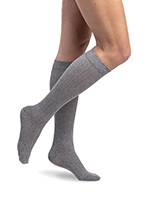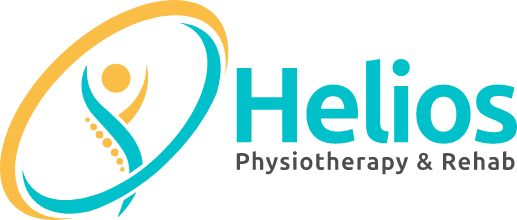 Compression therapy is a cornerstone treatment for individuals experiencing venous disorders and a vital preventive measure for leg health. Whether you are managing varicose veins, recovering from surgery, or simply looking to improve circulation, compression stockings are an essential part of the treatment process.
Compression therapy is a cornerstone treatment for individuals experiencing venous disorders and a vital preventive measure for leg health. Whether you are managing varicose veins, recovering from surgery, or simply looking to improve circulation, compression stockings are an essential part of the treatment process.
What is Compression Therapy and Why Is It Important?
Compression therapy works by applying targeted external pressure to the legs, with the highest pressure at the ankle, gradually decreasing as it moves up the leg. This graduated pressure helps to narrow dilated veins, allowing venous valves to function properly and facilitating better blood flow back toward the heart.
For healthy legs, early support means relief, recovery, and ongoing care. Compression therapy forms the foundation of all vein treatments, providing a long-term solution to manage venous conditions. Once a vein becomes dilated (such as with varicose veins), it no longer naturally regresses and requires permanent support through compression.
Compression stockings are especially useful after treatments like sclerotherapy or varicose vein surgery. They are vital in ensuring the success of the procedure and preventing the recurrence of vein problems.
The Muscle-Vein Pump: How Your Leg Muscles Help Circulation
The heart is responsible for pumping blood through the arteries, moving about 7,000 liters of blood per day throughout the circulatory system in an average adult. However, because of our upright posture, the veins in the lower body face a unique challenge — they need help to carry blood back against gravity to the heart.
This is where the muscle-vein pump, or calf muscle pump, plays a crucial role in circulation. This mechanism, located in the leg muscles, is vital for returning blood to the heart, especially from the veins in the legs, which have the longest distance to cover.
How the Muscle-Vein Pump Works
When you move, your calf muscles activate and thicken, squeezing the deep veins that lie between them. As the muscles contract, they press against the veins, narrowing them and increasing the speed of blood flow toward the heart. This helps overcome the effects of gravity and keeps the blood moving in the right direction.
The blood is supported by venous valves, which act like one-way doors, preventing blood from flowing backward. These valves are located on opposite sides of the veins. When blood flows toward the heart, the valves open, allowing it to pass easily. If blood tries to flow back down the vein, the valves close, blocking the reverse flow and preventing blood from pooling in the legs.
Each vein can have between 2 to 20 venous valves, depending on its size and location. This unique mechanism is what helps our bodies fight the effects of gravity and move blood efficiently back toward the heart.
How Compression Stockings Support the Muscle-Vein Pump
Compression stockings are designed to enhance the function of the muscle-vein pump. By applying graduated pressure to the legs, compression stockings assist the veins and the muscles in pushing blood back to the heart. This is particularly important for people with venous disorders, as it helps to prevent blood from pooling and reduces swelling in the legs.
How Compression Stockings Work
Compression stockings exert a precisely controlled external mechanical pressure on the veins and the leg. By compressing the veins, the stockings help to narrow their diameter, allowing the venous valves to close properly. This promotes smoother and faster blood flow, preventing blood from pooling in the legs.
Medical-grade compression stockings are designed to guarantee correct pressure levels, with a controlled pressure drop from bottom to top. This design accelerates venous blood flow back to the heart, significantly improving circulation and reducing swelling in the legs.
Why You May Need Compression Stockings
At Helios Physiotherapy and Rehab, we provide compression stockings for a variety of conditions, including:
- Tired, heavy, or aching legs
- Mild swelling in the ankles during pregnancy
- Swollen ankles after prolonged sitting or standing
- Fatigued and achy feet and ankles during travel
- Leg discomfort after prolonged periods of standing or sitting for work
- Mild varicose veins, particularly during pregnancy
- Recovery after varicose vein surgery or sclerotherapy
- Swelling from post-surgery inactivity
- Deep vein thrombosis (DVT) and venous ulcers
- Lymphedema and severe edema
Choosing the Right Compression Level
Compression stockings come in various pressure levels, measured in mmHg (millimetres of mercury), and selecting the right level is essential for your specific needs:
- Mild (15-20 mmHg): For minor swelling and tired legs, ideal for everyday use.
- Moderate (20-30 mmHg): Best for moderate swelling, varicose veins, and post-surgery recovery.
- Firm (30-40 mmHg): Used for more severe venous conditions like lymphedema and significant varicose veins.
Our experienced physiotherapists at Helios Physiotherapy and Rehab will help determine which compression level is right for you, ensuring the best results for your condition. We are Certified Compression Socks Fitter.
Benefits of Compression Stockings
Compression stockings offer a wide range of benefits, including:
- Improved circulation: They help blood flow more efficiently, reducing swelling and discomfort.
- Reduced risk of blood pooling: By compressing the veins, they prevent blood from collecting in the lower legs, which can lead to complications.
- Support after surgery: They are essential for ensuring the success of vein treatments like sclerotherapy and varicose vein surgery.
- Prevention of varicose veins: Compression stockings can help prevent the development of varicose veins, especially for those at high risk.
Frequently Asked Questions About Compression Stockings
1. Why should I wear compression stockings?
Compression stockings help with poor circulation, varicose veins, chronic venous insufficiency, deep vein thrombosis (DVT), and other venous issues. They are also recommended for pregnant women, frequent travelers, athletes, or anyone who spends long periods sitting or standing.
2. How do I know what compression level is right for me?
Compression stockings come in different pressure levels (measured in mmHg). Mild (15-20 mmHg) is for minor swelling and fatigue, Moderate (20-30 mmHg) is for varicose veins and post-surgery recovery, and Firm (30-40 mmHg) is for more severe venous conditions. Your physiotherapist will help you select the right compression level based on your needs.
3. Are there any side effects or risks with compression stockings?
When used correctly, compression stockings are generally safe. However, improper use or incorrect sizing can cause discomfort, skin irritation, or worsen circulation problems. It’s important to consult with your physiotherapist for a proper fit. If you experience pain, numbness, or skin changes, be sure to inform your physiotherapist.
HELIOS PHYSIOTHERAPY AND REHAB SERVICE AREAS
Serving clients in Cambridge, Kitchener, Ayr, St. George, Glen Morris, North Dumfries, and surrounding areas of Ontario.
At Helios Physiotherapy and Rehab, we are committed to helping you achieve better leg health through personalized compression therapy and physiotherapy treatments. If you are experiencing venous issues, contact us today to schedule a consultation and find out how compression stockings can benefit you.
CONTACT US
